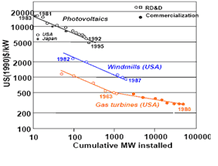Since the G8 2008 Summit announced its endorsement for pushing the launch of "at least 20 fully integrated industrial-scale carbon capture and storage demonstration projects worldwide by 2010", CCS has been receiving much increased attention from various circles, from government agencies and academic communities to the media and the public. CCS is also likely to be one of the 3 or 4 priority areas for US-China climate cooperation under the Obama Administration.
But in China, I have heard many people express doubts of the viability of CCS for China. These people include not only regular individuals, but also working-level and high-level policymakers, energy experts, and environmentalists. This is not surprising. Many people in the U.S. and other countries have the same concerns about CCS's high cost and possible safety risks. Chinese experts who are not enthusiastic about CCS also like to underline the energy penalty of CCS, i.e. the extra energy needed to capture, compress, and transport carbon dioxide and inject it deep underground. They point out that the additional energy is likely to come from coal, resulting in more coal consumption.
As an environmentalist, I don't necessarily think CCS is an ideal approach to cutting carbon emissions - avoiding CO2 emissions in the first place, like improving energy use efficiency and deploying low-impact renewable energy, is a better approach. But looking at the broad picture of the global warming trend and the need to stabilize atmospheric CO2 concentrations by the middle of this century, as well as looking into the detail of China's energy and economic development prospects, I recognize that CCS is likely one effective way of making deep CO2 emission reductions under certain conditions. At least given today's level of knowledge and technological ability, CCS appears to be one practical means to slash carbon emissions.
For China, current efforts in energy efficiency and renewable energy development alone won't level or decrease the growth of China's total CO2 emissions fast enough. It is commendable that China has further enhanced its attempt in recent years to raise industrial and building energy efficiency and expand renewable energy deployment.
• China's energy intensity has declined 4% per year on average over the past 30 years, according to recent Chinese media reports.
• The government's commitment to reducing energy intensity by 20% during the period of 2005-2010 is making headway - by the end of 2008 it already achieved a 10.1% decrease over the 2005 level, as announced by the central government earlier this year.
• On the renewable energy front, China's goal is not humdrum either - it aims to increase renewable's share in total primary energy consumption from 6% in 2005 to 15% by 2020 (though this includes a large hydropower component).
• Within that goal, the target for wind power was initially set at 30 GW in 2007, but increased to 100 GW in May 2009; solar power capacity was put at 40 GW for 2020, but also has been raised to at least 60 GW (see my colleague's blog).
• Like it or not, China also has an ambitious plan for nuclear power. Originally aimed to provide 40 GW by 2020, China now is thinking about building 60 -70 GW instead. This means building 60 or so new plants in ten years. But note that nuclear power's share in China's total energy mix will still be small - 4% corresponding to the original goal and 5% under the renewed plan.
Yet, various scenario studies, including a recent 2050 one by Chinese researchers at the Energy Research Institute,[1] all show that coal will continue to play a major role in powering China's economic development. In that 2050 modeling study, for example, under a "low-carbon economy scenario", coal's share in China's primary energy consumption will shrink from current near 70% to 54% around 2020 and to 36% by 2050, which is still a big portion. This scenario assumes, among other policy and financial measures, that China's energy efficiency in manufacturing will rise 40% by 2030; the costs of solar, wind and nuclear power will be greatly lowered to become commercially competitive; CCS with enhanced oil recovery will be used after 2020; and all new IGCC plants will have CCS beginning in 2050. Interestingly, the cost analysis in this study shows that the Business-as-usual scenario and the Low-carbon scenario will overall require similar amounts of investment (see my reproduced chart in English).
Source: Reproduced and translated from 2050 China Energy and Co2 Emissions Report (in Chinese), Science Press, Beijing, July 2009
Under the low-carbon scenario, China's total CO2 emissions will level after 2035. Many scientists in industrialized countries don't think such a pace is fast enough for global climate stabilization. So more radical measures, e.g. earlier and broader CCS deployment, may be needed. This raises the key questions of CCS' cost and technological feasibility.
Many CCS technologies are already mature:
• scrubbing CO2 from a gas stream (either flue gas from coal combustion or syngas from coal gasification),
• compressing CO2 into its supercritical state (above 31.1 °C and 7.39 MPa) so that it becomes a liquid,
• transporting the supercritical fluid through a pipeline,
• exploring and selecting a suitable geologic storage site,
• drilling injection wells to some 1000 -3000 meters deep,
• injecting the supercritical CO2 into the geological reservoir,
• sealing the well when the reservoir is full, and
• conducting follow-up monitoring to make sure the gas is not escaping.
Of course, further improvement on these technologies is desirable, especially to reduce the energy penalty of carbon capture. Reducing the energy penalty will reduce the cost of CCS. Right now, the penalty for a new post-combustion coal power plant is 31%, and for a new IGCC plant is 16%.[2] That's why IGCC is receiving attention, even though it is more costly in terms of capital investment.
Is there good potential for reducing the extra energy needed for CCS? I find that this graph showing historical cost trends for emerging energy technologies gives us some confidence. If other energy technologies like solar photovoltaics, windmills, and gas turbines have undergone constant cost reductions when scaling up, there is no reason that CCS technologies won't follow the same trend. That's why having a sufficient number of large-scale demonstration projects represents an important and urgently needed step.
 Source: IISA, 1996, from E. Rubin, March 2009: The Outlook for Improved CO2 Capture Systems (ppt), ETH Seminar, Zurich, Switzerland.
Source: IISA, 1996, from E. Rubin, March 2009: The Outlook for Improved CO2 Capture Systems (ppt), ETH Seminar, Zurich, Switzerland.
The potential safety risk of CCS is no higher than that of nuclear power, to say the least. The IPCC's Special Report on Carbon Capture and Storage (2005) says "Observations from engineered and natural analogues as well as models suggest that the [CO2] fraction retained in appropriately selected and managed geological reservoirs is very likely to exceed 99% over 100 years and is likely to exceed 99% over 1,000 years." So, based on our current knowledge, the chances are very high that almost all of the injected CO2 will stay underground for thousands to millions of years, if projects are properly sited, operated and regulated. According to researchers, on the thousand- year timeframe mineralization will become an important "trapping mechanism", i.e. more and more CO2 will react with the magnesium and calcium in the rock to form solid carbonates (basically becoming part of the rock).
Of course, even though we have all the needed technologies, deploying CCS at a large scale worldwide is no doubt a complex undertaking. But the global climate challenge cannot be solved without big global efforts. There is not sufficient experience in large-scale full-range CCS projects yet. That's why the G8 has called for launching large-scale demonstration projects, which will give us the knowledge concerning how to scale up CCS design and operation, system integration, site selection and monitoring, and the regulatory tools required to make CCS a safe and publicly acceptable mitigation option.
To wrap up, I want to mention a report on near-term CCS opportunities in China that we are developing jointly with a number of U.S. and Chinese experts. The full report will be finished next month, but the executive summary has just been published today.
[1]2050 China Energy and Co2 Emissions Report (in Chinese), Science Press, Beijing, July 2009.
[2] E. Rubin, March 2009: The Outlook for Improved CO2 Capture Systems (ppt), ETH Seminar, Zurich, Switzerland


